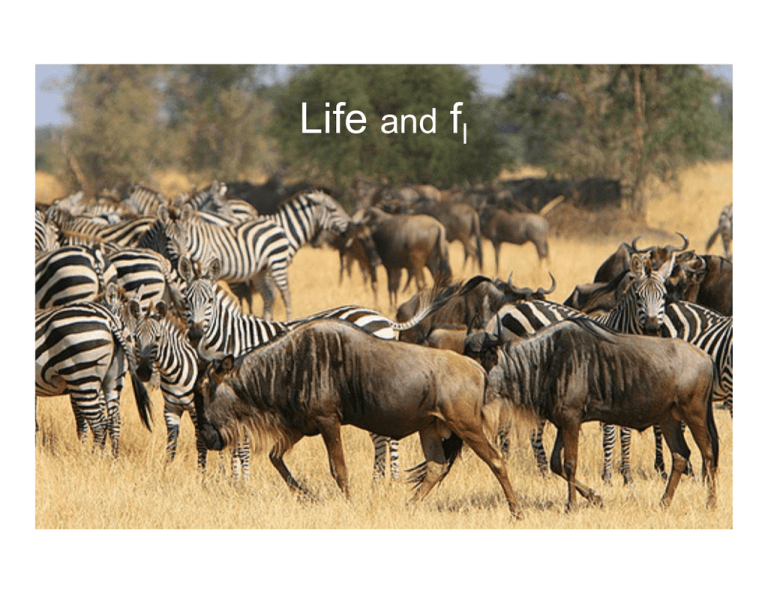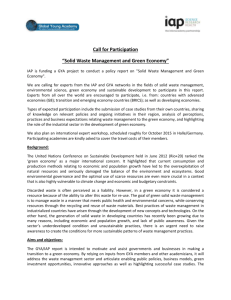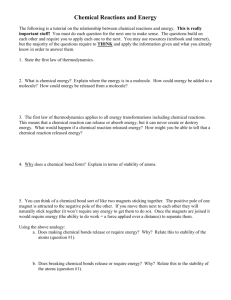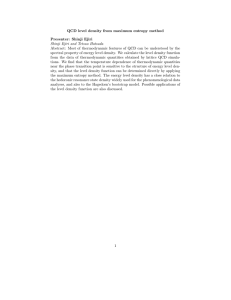Life f and
advertisement

Life and fl Recap N = N* fs • N* = 4 x 1011 • fs = 0.2 • fp = 1.0 N = 8 x 1010 Solar System • 8 planets • 3 in or close to habitable zone • Extrapolating from one example: – fp =1 – Nh = 3 • N = N* fs fp Nh = 2.4 x 1011 Where we are going… • We’ll return to habitable zones later • First, what needs to be supported? What is Life? And will you know it when you see it? Properties of Life* • Produces Order • Reproduces itself • Grows and Develops • Utilizes Energy • Responds to the Environment • Adapts and Evolves *as we know it, on Earth Definitions of Life • Thermodynamic: Produces order. Temporarily overcomes entropy. But are crystals alive? Definitions of Life • Thermodynamic: Produces order. Temporarily overcomes entropy. But are crystals alive? • Metabolic: Produces energy via chemical reactions. But is fire alive? Definitions of Life • Thermodynamic: Produces order. Temporarily overcomes entropy. But are crystals alive? • Metabolic: Produces energy via chemical reactions. But is fire alive? • Biochemical: Exhibits specific reactions; uses enzymes. Definitions of Life • Thermodynamic: Produces order. Temporarily overcomes entropy. But are crystals alive? • Metabolic: Produces energy via chemical reactions. But is fire alive? • Biochemical: Exhibits specific reactions; uses enzymes. • Darwinian: Self-sustaining and reproducing; capable of evolving. The Meaning of Life The Laws of Thermodynamics • Energy can be transformed, but never created nor destroyed (conservation of energy) • In a closed system, entropy always increases • Absolute zero, the complete absence of motion, is unattainable The Alternative Laws of Thermodynamics • You can not win • You can not break even • You can not get out of the game. Entropy Does life, by creating order, violate the second law of thermodynamics? No. Entropy must increase in a closed system. • Earth is not a closed system. • A decrease in entropy on Earth is more than compensated by the increase in entropy of the Sun. Summary of Properties • Produces Order • Utilizes Energy • Reproduces itself • Grows and Develops • Responds to the Environment • Adapts and Evolves • Thermodynamic • Metabolic • Thermodynamic; Darwinian • Darwinian • Darwinian • Darwinian Evolution Reproduction with Errors Earth - a Brief History 4.5 Gya: Earth forms in circumstellar disk 4.4 Gya: Mars-size object collides with the Earth • Original atmosphere is stripped • Moon forms in debris disk 3.9 Gya: surface is pulverized in the Great Bombardment 3.8 Gya: Oldest rocks; evidence for life • C12/C13 isotope ratios 3.5 Gya: first fossils (stromatolites) Life on Earth - a History All life on Earth is related: • It shares common biochemical mechanisms • It shares common DNA sequences Arose early on: first records about 3.8 Gya about 100 million years after the great bombardment Arose under adverse conditions Evolved fast: Essentially modern fossils by 3.5 Gya Elements of Life Tree of Life Classification of Life on Earth • Domain • Archaea • Bacteria • Eucarya • Kingdom • Phyla • Class • Order • Family • Genera • Species The original Linnaean system began with the Kingdom (Plants, Animals, Fungi, Protists, Bacteria) Your Classification • Domain : Eucarya (multicellular) • Kingdom: Animalia • Phylum: Chordata (notochord) • Subphylum: Vertebrata (spinal cord) • Class: Mammalia • Subclass: Theria (live birth) • Infraclass: Eutheria (placental) • Order: Primatia • Suborder: Anthropoidea • Infraorder: Catarrhini (Old world monkeys) • Family: Hominidae (hominids) • Genus: Homo • Species: Sapiens It’s a Long Way from Amphioxus What All * Life Has In Common • Carbon-based • Water-soluable • Organized into cells • DNA/RNA-based genetic material * On Earth Carbon • Atomic number 6 (6 protons) • 4th most abundant element • Isotopes: C12, C13, C14 • Valence +4 • Can form stable • Single, • double, or • triple bonds • Readily forms long chains • Forms closed rings Why not Silicon? Si also has valence = +4, but: • Si does not readily form double or triple bonds (the nucleus is larger, bonds must bend more) • Si-Si bonds are half the strength of C-C bonds • Si-H and Si-O bonds are stronger than Si-Si bonds • C-H and C-O bonds are as strong as C-C bonds • Si-O chains (silicone) are stable and unreactive • SiO2 (quartz) is very stable • Si does not form rings Water (H2O) • Abundant • Easily made, stable • Liquid over wide temperature range • Permits wide habitable zone • High heat capacity, high heat of vaporization • Moderates temperature fluctuations • Good solvent • a polar molecule • Non-reactive • High surface tension • UV self-shielding • Solid less dense than liquid • Ice floats Other Solvents Solvent TemperaHeat ture Range Capacity Heat of Vaporization Relative Surface Tension Relative Solvency (C) (Cal/gm/C) Water H 2O 100 1 595 1.0 1.0 Ammonia NH3 45 1.2 300 0.5 0.5 Methyl Alcohol CH3OH 159 0.6 295 0.33 0.5 (Cal/gm) Cells A membrane keeping the cellular mechanisms Inside, and the rest of the work outside. May or may not contain a nucleus Extreme Life • Viruses and Prions • Extremophiles – Thermophiles (heat) – Psychrophiles (cold) – Halophiles (salt) • Chemautotrophs (inorganic reactions) Evolution - A Fact of Life







